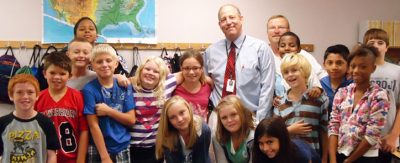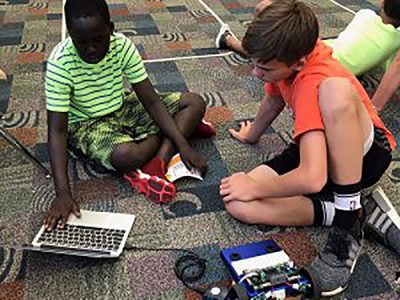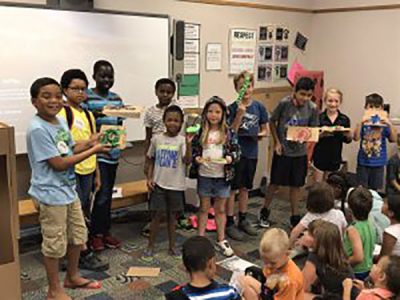Editor’s Note: The following was originally written and published by Blane McCann, superintendent of Westside Community Schools in Omaha, Neb., on his blog.
I recently attended the 40th anniversary of Confratute, sponsored by University of Connecticut’s Neag School of Education. This was the eighth or ninth time I have attended this very special event. As described by founders Joe Renzulli and Sally Reis, the event is a hybrid of a conference, institute and fraternity, or a “Confratutue.”
At each event, I learn so much that I am able to use in my daily work. The following is my reflection of my time learning over the years at Confratutue and the fact that I believe that all teachers must treat all kids as gifted students because they all learn in their own ways.

Consider the notion that any student with a commitment to learning is gifted. It is not only intelligence that plays a role, but also creativity and commitment. Giftedness is not just a test score.
How many students have we, as educators, seen who did not have a test score to qualify for a gifted program, but became an expert in an area of passion and interest? I’ve personally seen hundreds of students. I remember one learner vividly who I knew would become a meteorologist. Today, he is considered an expert on the weather of the Great Lakes region and is sharing his research at the University of Wisconsin-Madison with the National Weather Service. Task commitment can take students places they never thought possible.
Consider the notion that any student with a commitment to learning is gifted. It is not only intelligence that plays a role, but also creativity and commitment. Giftedness is not just a test score.
This broader definition of giftedness is one I learned from Dr. Joseph Renzulli, a longtime professor of educational psychology at the University of Connecticut, for whom the Renzulli Center for Creativity, Gifted Education, and Talent Development is named. I met Renzulli at a conference in 1996 and in the more than 20 years since, I have worked in three school districts as a building principal and superintendent, collaborating with him to apply his pioneering ideas about giftedness and personalized learning approaches in PK-12 settings.
Implementing change in public education is not easy. Renzulli understands this. He himself encouraged me to embrace the vulnerability I felt and he provided me with the courage needed to make changes based on what my students wanted and needed to be successful. I was able to help teachers see how student agency and student engagement could be improved along with their test scores. We built a school culture focused on learning and engagement for all students. I observed changes with our teachers as they implemented these practices in their regular education classroom. They took into consideration students’ interests and allowed for more student voice and choice as well as flexibility in their classrooms because they facilitated an enrichment cluster.
In working as superintendent of Westside Community Schools in Omaha, Neb., I wanted to put the joy and wonder back into learning after decades of high-stakes testing had sucked the joy from our classrooms. So I asked our staff the question: What if we could personalize learning for all kids in all classrooms?
Another of Renzulli’s principles — the Schoolwide Enrichment Model (SEM) — serves as an entry point for schools that want to do just this. I want all kids to be able to follow their passions and interests every day. Every one of them could be “gifted” if we could find ways to engage them in their learning. As I learned about personalized learning, I quickly saw the connection to SEM to this evolution of learning.

What connections did I make? First, students identify their interests and passions through a survey. Next, SEM is about student ownership of their learning. In a SEM cluster, students drive their learning with the help of the cluster facilitator. Additionally, teachers do not create a lesson plan prior to the cluster meeting but help student determine their own learning path through class discussions, which allows students to choose different learning paths.
From my 20 years of experience with SEM and now personalized learning, my colleague and I have identified five elements to personalize learning. Those elements are:
- Know your Students;
- Voice and Choice;
- Flexible Groups, Spaces and Mindsets;
- Data Informed; and
- Technology Support.
A teacher must know their students well before they can teach them. A teacher who knows their students well can allow for more voice and choice because they know their interests and their capacities to learn and work. Once students find their voice and make learning choices a teacher becomes more flexible. I had a teacher tell me she was letting go of deadlines because students wanted to make sure they submitted their best work and needed more time.
Data is used to inform our work with individual students. This data is critical for a teacher to map out a learning pathway that is personalized based on student needs, which can extend learning or help relearn content.
Finally, Westside Community Schools is a 1:1 learning environment. Our teachers enhance learning by using technology such as iPads and MacBook Air computers in our classrooms. We do this because we want our students to create personalized content and use individualized applications while they work at their own pace to master our standards and benchmarks through a personalized learning approach.
In working as superintendent of Westside Community Schools in Omaha, Neb., I wanted to put the joy and wonder back into learning after decades of high-stakes testing had sucked the joy from our classrooms. So I asked our staff the question: What if we could personalize learning for all kids in all classrooms?
Yes, I experienced many obstacles and barriers to building this culture. Most issues are about control and trust. We alleviate those issues by focusing on our district’s standards and benchmarks. However, I would hear comments such as “We don’t have time to implement this framework” and staff told me “The cluster did not exactly follow the curriculum” or “Students will miss critical learning time.” I explained that students would be applying district standards in many different, but authentic ways. In each district where I worked, the staff and I altered the daily schedule to accommodate student learning that allowed for this type of deep learning.

The results we now are seeing are definitely worth the journey. Our current results are measured with not only test scores but with engagement, with voice and choice, and with student ownership for their learning. At Westside Community Schools, reading scores are improving, and fewer students are in need of remediation. Further, our Gallup student and staff engagement scores are on the rise, demonstrating that people enjoy the teaching and learning that takes place in our classrooms.
I have seen similar results every time I have implemented these types of learning approaches. For instance, we first implemented SEM in our middle school in 1997. At John Bullen Accelerated Middle School in Kenosha, Wis., I observed an increase in student ownership for learning as well as an increase in student attendance and a decrease in poor student behavior. Achievement gaps closed. Student achievement increased. Students seemed to see the relevance in the subject matter based on their interests. Most importantly, students’ academic confidence grew. They knew they would accomplish their learning goals, especially disadvantaged students who are rarely given an opportunity to experience learning in this manner. SEM leveled the playing field.
Today, Westside has nine of 10 elementary schools and our middle school implementing SEM. In addition, our high school, with the help of a U.S. Department of Labor grant, is implementing a version of SEM through our Center for Professional Studies (CAPS) and other academic departments, such as business, where high school students operate and manage the Colosseum, our school apparel store. All of these students participate in a variety of meaningful, real-world learning opportunities, such as job shadows and meaningful internships.
One group of students recently took part in a CAPS project focused on designing and building a circulation desk using recycled materials from a historic district elementary school that was recently torn down to make room for a brand-new school. One of those students became so engaged that he is now pursuing a major in architecture this fall at the University of Nebraska-Lincoln. His excitement and engagement is off the charts, thanks to his involvement in this project.
I strongly urge other educational leaders to consider making this journey. I was able to transform the middle school where I was principal in a two- to three-year period. At Westside, the district is making tremendous progress with staff to transform learning for all students in four short years. It can be done.
Today, with the emphasis on personalizing learning for every student, SEM is a perfect entry to explore and help staff feel comfortable relinquishing classroom control and begin to trust their students. It is my sincere belief that if you commit to this journey that like my former student, it will take your learners places you never thought they could go.
This piece has been republished with permission. To view the original piece, visit Superintendent McCann’s blog. Follow him on Twitter @BlaneMcCann. Learn more about Confratute at confratute.uconn.edu.
 Facebook
Facebook
 Twitter
Twitter
 LinkedIn
LinkedIn
